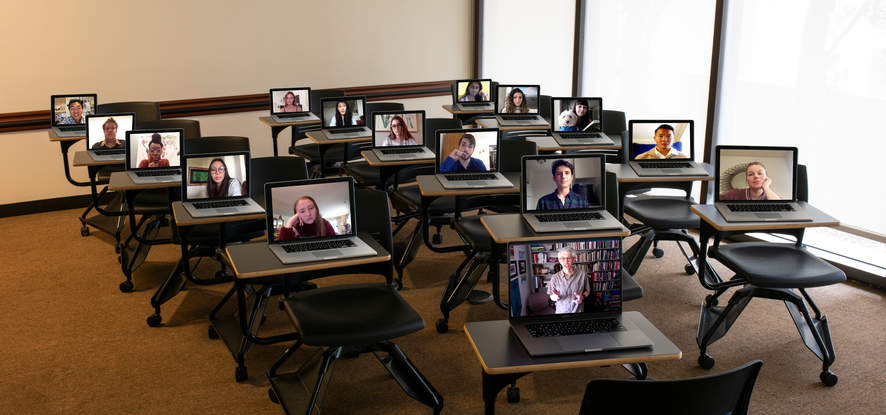The Other Side of the Screen: Teaching During a Pandemic
Like hundreds of colleges and universities around the world, Seaver College started the academic year in a remote learning environment. As professors and students navigate the challenges associated with distance learning, associate professor Marshall offers insights into how she makes lessons creative and engaging.

How do you keep students engaged with online learning?
Whether in person or online, I like to have a range of pedagogical tools to use for student engagement, depending on the concept taught, the needs of the particular group of students in my class, and on their group dynamic in any given class session. Online, I’ve tried a variety of tools for virtual collaboration to foster student engagement. One strategy that students have really appreciated has to do with how I communicate my expectations for their in-class participation. Each class day, an hour or two before my Zoom sessions, I send my students a course agenda (lesson plan) with all shared pedagogical resources embedded as links.
Students have shared that having the lesson plan ahead of time helps them to prepare their answers to questions and mitigate their language anxiety, since they are more likely to participate if they are confident in their answers. I use breakout rooms at least once per class session so that students can connect with one another. In breakout groups, I ask students to make notes in the slideshow or on the Jamboard, then as a whole class, each group nominates a few spokespersons to describe their collaborative product.
As this is a learning curve for both professors and students, I often ask for student feedback and with their input, have found ways to better foster students’ participation, like monitoring Zoom’s “raised hand” feature and using Zoom polls. Navigating these challenges has made my pedagogy more versatile, I think. In fact, there are teaching tools that I’ve begun to use during this period of online instruction that I will likely continue to use when I am back in the classroom.
I also try to visit each group while they’re away from the main session’s Zoom “gallery.” I have really enjoyed connecting with my students in these more personal contexts. In addition, I start almost every class session with a “check-in” question —in French—to see how students are doing. I’ve received really positive feedback from students on this: they say that it helps them stay connected with one another, and they also feel connected to the greater Pepperdine community.
What are some ways you make your lessons creative?
One challenge I’ve faced with virtual teaching is finding a good replacement to the classroom white board—especially for collaborative learning activities. Since I use the Google Suite a lot, I thought it would be nice to create something I could share via Google Drive and that I could prepare ahead of class. I’ve asked students to look up a cultural topic and put a sticky note about what they found on the class’s shared Jamboard, another feature of the Google Suite, prior to our class period.
Students bring their reading assignment notes to the Zoom session, and in breakout rooms, each group compiles and condenses their groups’ responses onto a Jamboard frame. We then use these co-constructed Jamboard frames as a basis for our class discussion. Finally, I’ve also hand-designed a Jamboard ahead of time (showing figures I would usually draw on the board) and used it to present theoretical concepts. Having the drawing pre-made made better use of class time, and we used some extra frames in the Jamboard to continue our discussion.
It’s true that these sorts of collaborations could be done other ways, but I think the Jamboards are visually pleasing, and it’s very nice that they have multiple frames, so that you don’t have to erase anything—sometimes I run out of board space in the classroom! I may continue to use Jamboards for certain collaborative activities even when I have access again to physical whiteboards.
To help spruce up my digital lesson plans themselves and prevent them from looking dry, I’ve incorporated the use of emojis indicating different classroom activities. For instance, if it’s a group activity or discussion, I signal it on the lesson plan with an emoji speech bubble.

What advice do you have for students currently struggling with distance learning?
My students and I have been in active discussion about what is effective for fostering their online learning and on what is less effective. This open communication is exceptionally important for a good online learning environment. Actually, this is my first piece of advice to students: if you are struggling with online learning, reach out to your professors! Active communication is key right now, especially since you can’t just drop by our offices for a quick chat. Please reach out to us and let us know how we can provide a positive learning environment.
The second thing I would recommend to students is to establish a fairly set weekly schedule. I’ve encouraged my students to plan out when they will work and when they will relax. It’s very easy when attending or teaching class at home to think that there is always something that one should be doing, but breaks are necessary! And with all of our sitting, exercise and fresh air are especially important.
I hope students are encouraged that most of the Seaver faculty members were in contact with each other over the summer, trading tips on what has worked online or what might be an interesting method to better promote student learning. These conversations with my colleagues have greatly encouraged me and have reminded me what a privilege it is to be part of the Pepperdine community. It’s truly a team effort! We are committed to giving our Seaver students a world-class education and are working very hard to do this right now online.